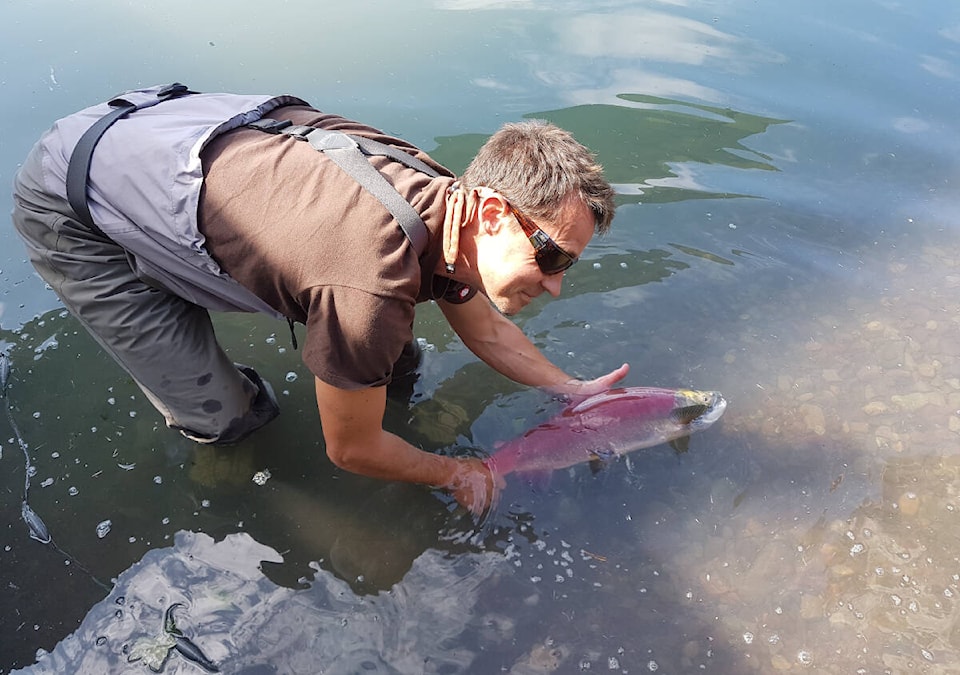Comparing past sockeye populations in the Skeena watershed to their present-day counterparts may hold the key to preserving the species, according to an SFU postdoctoral fellow.
Michael Price, who resides in Smithers, found in his Ph.D. research that a warming climate is making juvenile Skeena sockeye grow larger and is changing the habitats in which the young fish can thrive.
Price found that small, warmer and more shallow lakes that juvenile sockeye used to thrive in are now becoming less suitable for the fish, with larger, deeper and colder lakes taking their place as the optimal habitat for sockeye to grow before they make the daunting trip to the ocean.
“There’s a broad pattern in that populations of sockeye that we looked at have increased in growth over time,” said Price. “However, when you look at it from a population-to-population perspective, some are doing better than others, some are seeming to respond… more positively than others.
“That gives us an indication of which types of habitats and which populations may do well under forecasted increases in temperature associated with climate change, and which populations and their habitats may not do so well under increasing temperatures.”
Sockeye eggs are spawned in small streams before the juveniles swim down to nearby lakes, where they bulk up for one to three years, then make their journey out to the ocean. Price said in the past sockeye in warm lakes would be prepared for their adult lives faster, a trend that has shifted.
READ MORE: Criminal contempt trial of pipeline opponents begins in Smithers
By analyzing fish scales from 100 years ago, Price was able to find that juvenile sockeye are now more successful in the cold depths of larger lakes, mainly because they have room to escape the warm surfaces of the lake. Price said juvenile sockeye are basically squeezed out of more shallow lakes, as they go deeper to enjoy the cold water, but then lose oxygen. Deep lakes allow juvenile sockeye to travel deep enough to remain in cold water, yet maintain optimal oxygen levels.
”Fish, like everything, has a threshold at which they can live,” Price said. “Temperature is a key driver for them and if it gets too hot, it becomes detrimental to them. Essentially, they’ll seek cooler waters, especially in the summertime when it gets hot. The surface temperatures are hot, but that’s not where they’re occupying the space.
“They’re going down deep into the cooler or oxygen-rich parts of the lake, and so depth plays that role. It provides them with more habitat in which to live in greater buffering capacity against higher temperatures, and so looking forward with forecasted increases in temperature associated with climate change… they’ll need these areas of refuge from high summer temperatures and deep lakes provide that, whereas shallow lakes do not.”
Glacial lakes that used to have less wildlife due to their frigid nature are now becoming more habitable for fish due to climate change, according to Price.
Research for Price’s project began in 2017, and it has not always gone smoothly. He said the fish scales collections he needed from 1923 to 1920, held by Fisheries and Oceans Canada (DFO), had to be tracked down after being missing for approximately 50 years.
Once a colleague miraculously found the collections after a year of searching, Price said the work was not done. His team had to go through the labourious task of digitizing thousands of fish scale records from the 20th century, while also having to raise funds to operate the sampling side of the project.
”Before we could really talk about anything, the scales from each fish had to be identified to a population, so they were sent to a genetic lab, assigned to a population, and then we could then work with it,” Price said.
“The biggest relief happened after the first set of scales were run, so that’s 1913 to 1920, because if none of that happened, then my whole proposal for my thesis would be out the window as it predicated on being able to identify scales.”
One of the most interesting components of the work was being able to look back into history, while also projecting how it will impact the future, according to Price.
”I reflect a lot. I love history. But it’s also important to learn from that to better understand where we’re going and where might these fish populations be in the future, which ones should we focus our efforts on.”
He said that while the first three chapters of his Ph.D. project focused on the past filled with sockeye struggles, his fourth chapter gives the future of sockeye some hope.
“It was… deep into the past, and it was a challenging story because it was quite depressing, right? These sockeye populations, they’ve been diminished in abundance by upwards of 90 per cent for many. And the diversity has shrunk throughout the watershed. It’s had implications for wildlife and Indigenous food security.”
But the current chapter he is working on is a potential good news story, he said.
“These fish are growing more now than they had in the past.”
Price said his research shows that humans have an opportunity to preserve salmon habitats and restore some of their depleted numbers, a privilege that should not be taken for granted.
“It’s not all doom and gloom. It’s no doubt we need to be concerned about climate change. Undoubtedly it’s going to impact them in a big way, but not all is lost,” he said.
“It’s places like the Skeena, these northern watersheds that I think do stand a very good chance of hosting thriving sockeye populations in the future.
“But we hold those cards and in these freshwater environments, what happens on the land influences these habitats, so it will be up to us to ensure that these habitats remain in a condition that’s suitable for salmon to thrive.”
